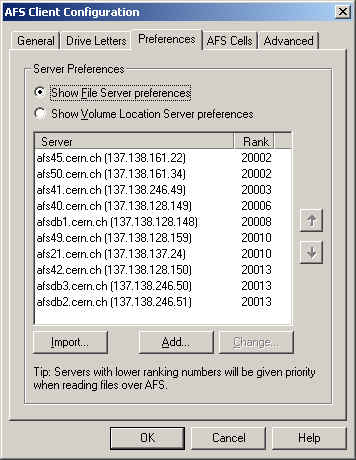


| About these pages |
5 Aug 2009: a new version 1.5.60 of the client has just appeared and older ones no longer seem to work. I followed the instructions G:\Applications\IBM\OpenAFS-1.5.60\CERNREADME.txt very carefully, including the Windows Hotfixes, and it seems to be OK for me.
As usual I have mapped the CERN AFS root to drive P: in Windows (if you use some my software, you should do the same). I also map drive I: to my AFS home directory.
Adapted from my older notes for NT. There are some other notes but I think they are now partly out of date.
The IBM AFS client for Windows allows direct access to AFS files from Windows. Advantages:
Almost everything works in the obvious way. The root of AFS appears as drive P: in my setup. As always in Windows, you can have command lines if you really want..
Warning: use of the AFS Client does not seem to be encouraged by the NICE support in CERN because earlier versions did lead to problems. The latest version has gotten rid of those and I have not come across any others (except the business about Unix links mentioned below). Just to say that I don't take responsibility - I wrote this page for my personal use and to save myself time when other people ask me about it (which has happened many times ....).



Most problems seem to come from the AFS servers or the network, not the AFS Client. On those days when AFS is having problems, it is a good idea to click the padlock, go to Advanced and just Stop Service while you do something else.
Most of the time, I avoid using Unix links and I wish others would too. When I really have to create them, which is much less often than many think, I give them the extension .link.
Click the padlock, to see how.
Instead of having to remember those weird Unix commands like fs listquota you can right click a file or directory and use the AFS menu.
When I first installed an earlier version of the AFS client on my laptop, I found that it caused problems when I disconnected from the network. So for a while I was also careful not to include AFS files in synchronisations.
However I have recently installed the latest version on my laptop portable computer. Since the user account I use there is different from my AFS one, there is no automatic AFS access when I start up and the mapped drives appear with red crosses in My Computer to show they are not available. When I do actually need it, I simply click the padlock in the system tray and obtain a token with the appropriate AFS account name and password. Before disconnecting the laptop from the network, I simply stop the AFS service. This works perfectly well for me.
Now (May 2004), I am getting a little more adventurous. I have just tried making an AFS folder available offline using the Windows XP synchronization manager. This seems to work fine. If the laptop is disconected from the network, or the AFS client is not running, then I have offline access to the files. As usual, it is important to pay attention to the little flashing computer icon in the notification area that tells you about offline changes that have not been synchronized. So this is highly provisional but it would be very nice. I am thinking about making the LHC optics MAD file database available offline for work with the Windows MAD-X.
In July 2004, there was a new version of the AFS Client G:\Applications\IBM\OpenAFS-1.3.70 which seems to deal with these things in a different, possibly better, way. I h ave not quite understood it yet myself. See the afs-install-notes.txt file and this useful FAQ.
- CERN AFS users
- LHC projects
- AFS scratch space, etc.
Watch out however for other drive letters getting AFS assigned to them (this used to happen on NT ...). This messes up shortcuts (it does not seem to happen any more).
the infrastructure group @ csail
SET EOLOUT LFso that it saves files in Unix format. See Help EOLOUT in KEDIT. It might very occasionally be necessary to reset to CRLF for certain files used by old Windows programs.
KEDIT also works very well in AFS. The DIR command provides a directory listing, sorting and navigation that is much faster and easier to use than Emacs'.
To convert a file from DOS to Unix format, I wrote a function in the JMJUtils`BumpEtc` package (loaded by default with my usual setup)
DOStoUnix["file"] changes the DOS line end characters in a file to Unix ones.I often generate plain text files (e.g. MAD input) with Mathematica. Under Windows, the OpenWrite command has the options
In[909]:=Options[OpenWrite]
Out[99]=
{DOSTextFormat->True,FormatType->InputForm,PageHeight->22,
PageWidth\->8,TotalHeight->\[Infinity],
TotalWidth->\[Infinity],CharacterEncoding\[RuleDelayed]"ASCII",
NumberMarks\[RuleDelayed]$NumberMarks}
so all you have to do is
SetOptions[OpenWrite,DOSTextFormat->False]to set it generally or
OpenWrite[ ...., DOSTextFormat->False]in a particular call. For Mathematica read by itself it doesn't matter anyway.
Not yet seen with Windows 2000, but let's keep the info here:
Subject: AFS skew> The 'AFS clock skew' problem has been seen elsewhere
on several
> occasions, fortunately in all cases it has
come down to the same quirk in
> Windows/NT setup:
>